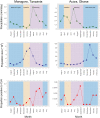Seasonal shedding of coronavirus by straw-colored fruit bats at urban roosts in Africa
- PMID: 36107832
- PMCID: PMC9477308
- DOI: 10.1371/journal.pone.0274490
Seasonal shedding of coronavirus by straw-colored fruit bats at urban roosts in Africa
Abstract
The straw-colored fruit bat (Eidolon helvum) is a pteropodid whose conservation is crucial for maintaining functional connectivity of plant populations in tropical Africa. Land conversion has pushed this species to adapt to roosting in urban centers across its range. These colonies often host millions of individuals, creating intensive human-bat contact interfaces that could facilitate the spillover of coronaviruses shed by these bats. A better understanding of coronavirus dynamics in these roosts is needed to identify peak times of exposure risk in order to propose evidence-based management that supports safe human-bat coexistence, as well as the conservation of this chiropteran. We studied the temporal patterns of coronavirus shedding in E. helvum, by testing thousands of longitudinally-collected fecal samples from two spatially distant urban roosts in Ghana and Tanzania. Shedding of coronaviruses peaked during the second part of pup weaning in both roosts. Assuming that coronavirus shedding is directly related to spillover risk, our results indicate that exposure mitigation should target reducing contact between people and E. helvum roosts during the pup "weaning" period. This recommendation can be applied across the many highly-populated urban sites occupied by E. helvum across Africa.
Conflict of interest statement
The authors have declared that no competing interests exist.
Figures



References
-
- DeFrees SL, Wilson DE. Eidolon helvum. Mammalian Species. 1988; 1–5.
-
- Cooper-Bohannon R, Mickleburgh S, Hutson AM, Bergmans W, Fahr J, Racey PA. Eidolon helvum. The IUCN Red List of Threatened Species. 2020. https://www.iucnredlist.org/species/7084/22028026.
-
- Mutere FA. Delayed implantation in an Equatorial fruit bat. Nature. 1965;207: 780.
-
- Funmilayo O. Ecology of the straw-coloured fruit bat in Nigeria. Rec Zool Afric. 1979;93: 589–600.

